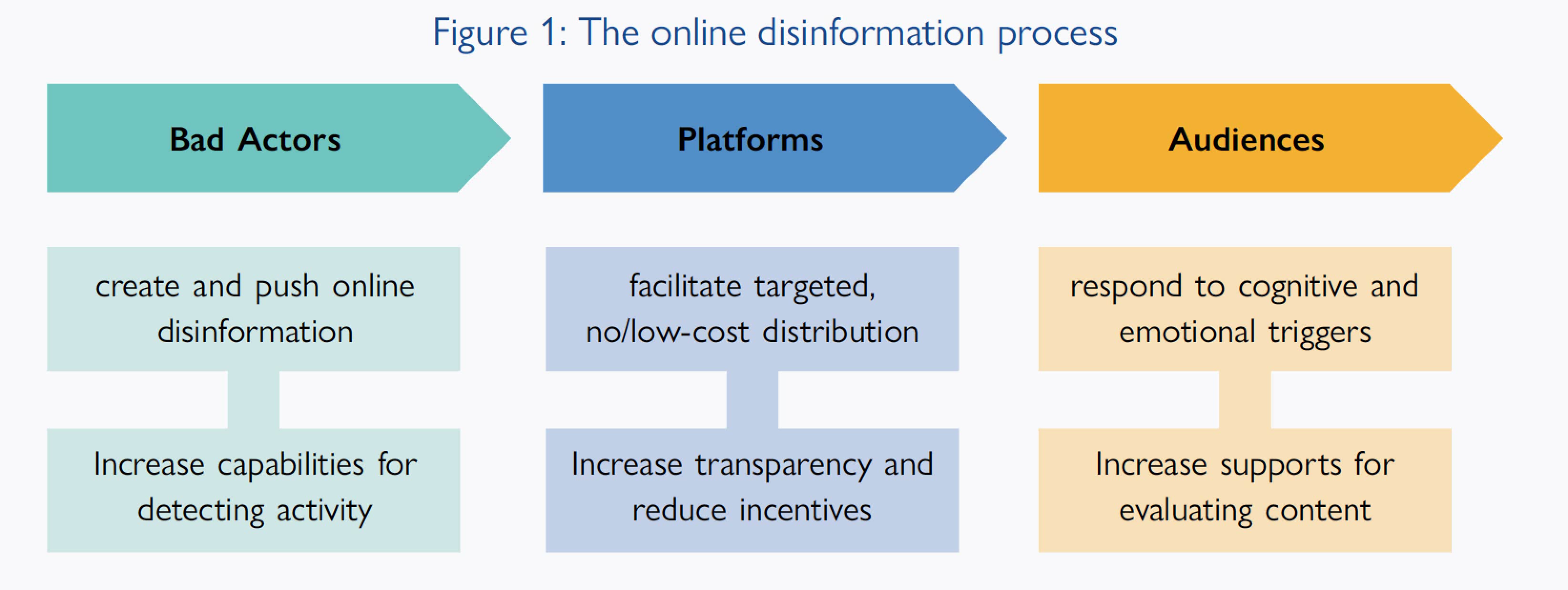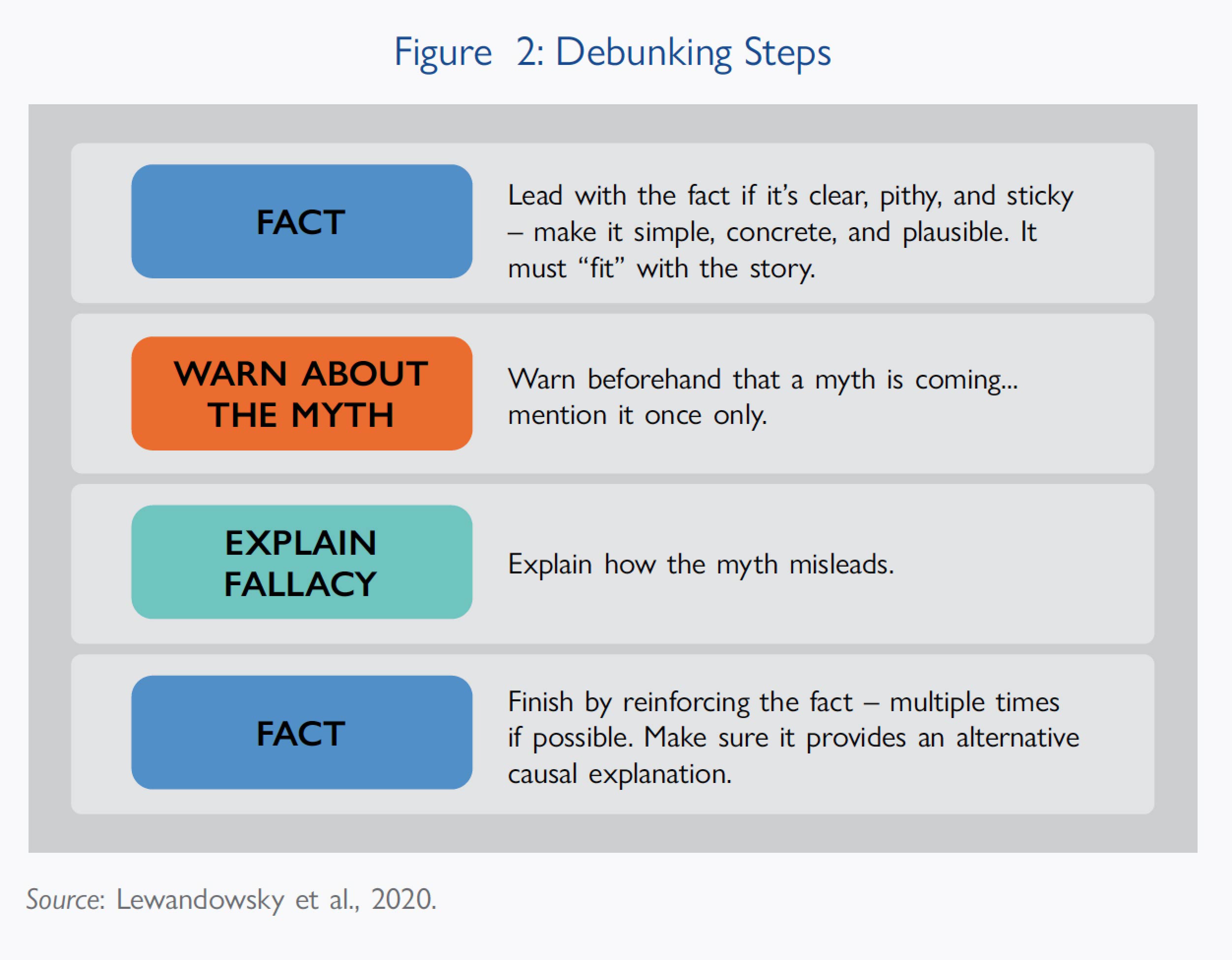Disinformation about migration
What is the difference between disinformation and misinformation?
Although definitions vary, disinformation is typically defined by its nefarious intent. Disinformation is false information that is created or disseminated with the intention to deceive the public for financial, political or social gain. In contrast, misinformation is false information that is shared without an intention to deceive. For example, a journalist might misprint a financial sum, but such unintentional mistakes will be acknowledged and corrected. In practice, disinformation and misinformation often overlap. For example, disinformation actors may promote a false story about migrants and members of the public may believe and share the story on the assumption that it is true.
The online disinformation process
The online disinformation process: reduced to its basic constituents, online disinformation, when it is successful, is a process that involves different actors and consecutive stages. In essence, bad actors create and push disinformation using online platforms as a means of distribution and promotion, while audiences give disinformation meaning and impact through their willingness to engage with it (See figure from Ch 8, WMR 2022.)

Key resources on the topic
- Disinformation about migration (WMR 2022, Ch. 8)
- Migrants’ contributions and disinformation (WMR 2020, Ch. 5)
Disinformation via technology
While the advent of the Internet promised a new frontier for freedom of expression and access to information, the online world is dominated by a small group of companies. These have grown far beyond their original focus – online shopping, web search, social networking – to become vast infrastructures upon which entire sectors of social and economic life are dependent. The business model is relatively simple: they offer users free access to content and services, while accumulating data that generate revenue through personalized advertising and other data-based services.
Disinformation in society and politics
In many countries, high-profile political actors have normalized disinformation about migration and rely on sympathetic media to do so. Often, these arguments centre on economics. Public anxieties about economic implications and social change are channelled against migrants, even though unemployment rates and wage deflation are the result of State economic policies and not migration. In South Africa, for example, studies consistently find that migration is a net economic benefit for the country, but migrants are scapegoated as a cause of high unemployment. In the United States, Donald Trump’s 2016 election campaign generated fears about Mexicans “swarming” over the southern border and promised to “build a wall” to protect the integrity of the State. Although Trump’s rhetoric was largely directed at Mexicans, hyperpartisan media outlets extended the fearmongering to include Muslims. In the United Kingdom, pro-Brexit rhetoric focused heavily on migration from Eastern Europe and the Middle East. Legal European Union migration was frequently confused with asylum-seeking as the Vote Leave campaign stoked up fears of an imminent arrival of millions of Turks and the right-wing press amplified these views.
Disinformation in media
Journalists are frequently criticized for providing negative coverage of migration. In some outlets, the use of fear as a framing device results in a perpetual flow of “bad news” about migrant crime, public unrest and violence. As such, news media provide bad actors with stories that can be repurposed and decontextualized to promote their own agenda. During the so-called refugee crisis of 2015–2016, European news media played a central role in framing the arriving refugees and migrants as a crisis for Europe, while affording little attention to migrants and their experience. This narrative also prevails in North Africa, where media coverage often accentuates discrimination and racism. Stereotyped and negative images of migrants perpetuate a discourse of migration as an “invasion” or a “burden”, which exacerbates prejudice and hostile attitudes. These views have been linked to the rise in anti-immigrant political parties and the intensification of anti-immigrant rhetoric in politics.
Building societal resilience to disinformation
There is growing evidence that succinct and repeated corrections can reduce misperceptions. A study of misperceptions about migration found that providing correct information reduced negative attitudes towards migrants, while also increasing factual knowledge. However, the content and format of a correction matter. Content matters, because simply stating that information is wrong may do little to dislodge misperceptions. In contrast, providing an explanation is more effective, because it helps the audience to update their knowledge. Format matters, because audiences might only skim the content. If the correction fails to prioritize correct information or puts undue emphasis on false claims, then the important facts may be lost. To avoid these scenarios, best practice recommends a “truth sandwich” approach, whereby the correction begins with correct information before explaining the nature of the disinformation and why it is incorrect. In the final step, the correct information is reinforced again.
Debunking steps

Figure: Debunking steps
Reflection questions
Describe in your own words the difference between disinformation and misinformation.
Please provide an example of disinformation in the media.
What is the “truth sandwich” approach to combat disinformation?